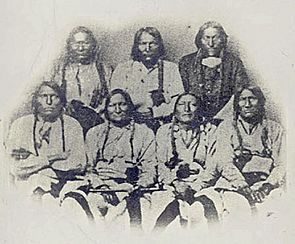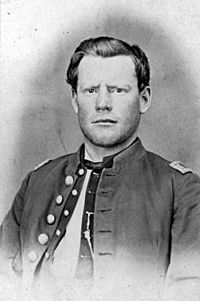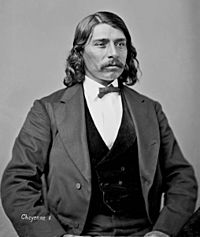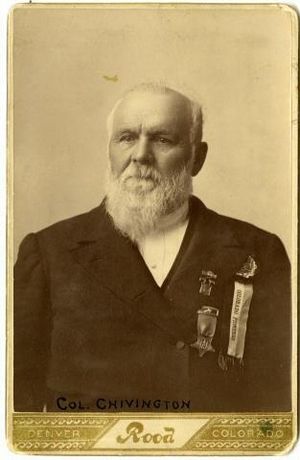John Chivington facts for kids
Quick facts for kids
John M. Chivington
|
|
|---|---|
 |
|
| Born | January 27, 1821 Lebanon, Ohio |
| Died | October 4, 1894 (aged 73) Denver, Colorado |
| Place of burial |
Fairmount Cemetery, Denver, Colorado
|
| Allegiance | United States of America |
| Service/ |
United States Army Union Army |
| Years of service | 1861–1864 |
| Rank | |
| Commands held | 1st Colorado Infantry Regiment 1st Colorado Cavalry Regiment 3rd Colorado Cavalry Regiment |
| Battles/wars | American Civil War |
| Other work | Methodist preacher |
John Milton Chivington (born January 27, 1821 – died October 4, 1894) was an American Methodist pastor and a Mason. He served as a colonel in the United States Volunteers during the American Civil War. He was part of the New Mexico campaign.
Colonel Chivington became well-known for leading a group of 700 volunteers from Colorado Territory. This group was involved in the Sand Creek massacre in November 1864. During this event, many peaceful Cheyenne and Arapaho people were harmed or killed. About two-thirds of those affected were women, children, and babies.
A special committee in the U.S. government looked into the event. They strongly criticized Chivington and his soldiers. However, he was not put on trial by the army. The main result for Chivington was public criticism, and his plans for a political career ended.
Before the Sand Creek event, in 1861, he became the first Grand Master of Masons in Colorado. Some Freemasons who were present at Sand Creek spoke out against Chivington's actions. Others supported him.
Contents
Early Life and Ministry
John Chivington was born in Lebanon, Ohio on January 27, 1821. His parents were Isaac and Jane Chivington. His father had fought in a battle under General William Henry Harrison.
Chivington was drawn to Methodism and became a minister. He started his work in 1844 in Illinois. He served the Illinois conference for ten years. In 1853, he joined a Methodist missionary trip to the Wyandot people in Kansas.
He spoke strongly against slavery. This put him in some danger. Because of this, he was advised to leave Kansas and move to Nebraska.
The Methodist Church then moved Chivington to a church in Omaha, Nebraska. He left this job after a year. Some people felt he was not always serious enough for a minister.
In May 1860, Chivington and his family moved to the Colorado Territory. They settled in Denver. He worked to set up missions in the mining camps in Park County, Colorado. He was chosen to lead the new Rocky Mountain District. He served in this role until 1862.
Chivington stopped performing his duties as a leader. Because of this, he was not given the role again in 1862. In the Methodist Church at that time, this meant a minister was effectively retired. Some believed he was removed because he was involved with the military. Even so, he remained involved in Methodist matters. His name was on the board of Colorado Seminary, which later became the University of Denver.
Civil War Service
When the American Civil War began, the governor of Colorado, William Gilpin, offered Chivington a job as a chaplain. But Chivington said he wanted to fight. He became a major in the 1st Colorado Infantry Regiment.
During a Confederate attack in New Mexico, Chivington led a group of 418 men. On March 26, 1862, they surprised about 300 Confederate soldiers. Chivington's men won this small fight. This helped the morale of the Union army.
On March 28, Chivington was sent to circle around the enemy. His orders were to attack the Confederate army from the side. While waiting, his scouts found the entire Confederate supply train nearby.
Chivington's group, which included some Colorado Mounted Rangers, went down the slope. They quietly approached the supply train. After waiting for an hour, they attacked. They captured or chased away the small Confederate guard without any losses. Chivington ordered the supply wagons to be burned. He also had the horses and mules killed.
Meanwhile, the main Battle of Glorieta Pass was happening. Chivington returned to find his army retreating. The Confederates had won the battle. But because Chivington destroyed their supplies, they could not continue their advance. They were forced to retreat back to Texas. Chivington's actions completely changed the outcome of the battle.
Chivington was praised for his quick action at Johnson's Ranch. Some people thought he should have returned to help the main army sooner. But his actions led to the Confederate retreat.
In April 1862, Chivington became a colonel of the 1st Colorado Cavalry Regiment. Some complaints were made against Chivington. A captured Confederate chaplain wrote that Chivington had threatened to harm prisoners. In November 1862, Chivington was made a brigadier general, but this appointment was later canceled.
Sand Creek Event

In the fall of 1864, some important events happened. Major Edward W. Wynkoop received a letter from Black Kettle. Black Kettle was a Cheyenne chief. He wanted a peace meeting and to exchange prisoners. Wynkoop successfully met with several Cheyenne and Arapaho chiefs, including Black Kettle. They arranged for some prisoners to be released.
Wynkoop and Captain Silas Soule then went to Denver with the released prisoners and some chiefs. Wynkoop convinced Governor John Evans to meet with the chiefs. This meeting was called the Camp Weld Conference. Governor Evans offered protection to Native Americans who would surrender at Fort Lyon. The chiefs agreed. They gathered their peaceful tribes and camped about 40 miles north of Fort Lyon, at Big Sandy Creek.
Around the same time, Governor Evans got permission to create the 3rd Colorado Cavalry Regiment. This group was made of volunteers who would serve for 100 days. The goal was to protect Denver and the Platte road. This regiment was led by Chivington. Governor Evans had made people worried about Native American attacks. He and Chivington hoped that successful military actions against Native Americans would help their careers. However, most of the Native American war parties were far away.
By October 1864, the 100-day service for the 3rd Colorado Cavalry was ending. Chivington's own military service was also about to expire. This meant he would soon lose his command. Chivington complained to his superior, Samuel R. Curtis, that Major Wynkoop was too friendly with the Native Americans. Curtis replaced Wynkoop with Major Scott Anthony. Major Anthony agreed with Chivington's goal of dealing harshly with Native Americans.

After moving his people, mostly Southern Cheyenne, Black Kettle learned that supplies would no longer be given out. He sent most of his warriors to hunt. Only about 60 men remained in the village. Most of them were too old or too young to hunt. Other Native American warriors were not part of this camp.
In November, Colonel Chivington and his 800 troops left Fort Lyon. They were from the 1st and 3rd Colorado cavalry regiments. They also had a company of the 1st New Mexico Volunteer Infantry. They marched close to the reservation. On the morning of November 29, 1864, Chivington ordered his troops to attack.
Captain Silas Soule believed the Native Americans were peaceful. He refused to follow Chivington's order and told his men not to fire. However, other soldiers in Chivington's force immediately attacked the village. The Native Americans raised a U.S. flag and then a white flag. But the soldiers kept firing. This attack became known as the Sand Creek massacre.

The Colorado forces had 15 killed and more than 50 wounded. Most of these were from friendly fire. It is estimated that between 150 and 200 Native Americans died. Nearly all of them were women and children. Chivington later said that his forces had killed many Native Americans. He claimed few were women or children. But others spoke against him.
A Cheyenne witness named Edmund Guerrier said that about 53 men and 110 women and children were killed.
At first, Chivington's actions were celebrated as a victory. He claimed his forces had won a battle against hostile Cheyenne. But Captain Soule and his men spoke out. This led to a U.S. Congressional investigation. The investigation concluded that Chivington had acted wrongly.
Soule and some of his men testified against Chivington. Chivington called Soule a liar. Within three months, Soule was killed by a soldier who had been under Chivington's command. Some people thought Chivington might have been involved.
Irving Howbert, who was a cavalryman at the time, later defended Chivington. He said that Native American women and children were not attacked directly. He claimed a few who did not leave the camp were killed once fighting started. He also said that the number of warriors in the village was about the same as the cavalry force. Howbert argued that Chivington was responding to Native American attacks on wagon trains and settlements. He said evidence of attacks on settlers was found in the Native American camp.
Howbert also said that the report given to the United States Congress by Lieutenant Colonel Samuel F. Tappan was not accurate. He believed Tappan gave a false view because Tappan and Chivington were rivals.
Chivington was soon criticized for his role in the event. He had already left the Army. After the American Civil War, a general pardon meant he could not face criminal charges. An Army judge publicly called the Sand Creek massacre "a cowardly and cold-blooded slaughter." The public was very upset by the event. This led to pressure to change how the government dealt with Native Americans. Congress later decided against a general war with Native Americans in the Middle West.
Later Life and Passing
Chivington left the army in February 1865. He then became a freight hauler, but was not successful. He later married Sarah. She divorced him in 1871.
Public criticism kept Chivington from being involved in politics. He could not join Colorado's campaign to become a state.
In 1868, Chivington went to Washington, D.C. He tried to get money for damages caused by Native Americans, but he was not successful. He returned to Omaha. He later lived briefly in California.
Chivington then returned to Ohio to farm. He later became an editor for a local newspaper. In 1883, he tried to get a seat in the Ohio legislature. But he withdrew when people brought up the Sand Creek Massacre.
He returned to Denver. He worked as a deputy sheriff until shortly before his passing. He died from cancer in 1894. His funeral was held at Trinity United Methodist Church. He was buried at Fairmount Cemetery.
Until the end of his life, Chivington believed that the Sand Creek event was a successful military action. He always said, "I stand by Sand Creek."
Legacy
In 1887, a settlement in Colorado was named Chivington, Colorado after John Chivington. This railroad town was quite close to the site of the massacre. In the 1920s and 1930s, many people left the town because of the Dust Bowl. However, some buildings still remain.
Because Chivington was a Methodist preacher, the United Methodist Church expressed regret in 1996 for the Sand Creek massacre. They apologized to the Southern Cheyenne for the actions of "a prominent Methodist."
In 2005, the City Council of Longmont, Colorado agreed to change the name of Chivington Drive. This happened after a twenty-year effort. People had protested against honoring Chivington because of the Sand Creek Massacre. The street was renamed Sunrise Drive.
In Popular Culture
- In the 1951 Western film Tomahawk, a character mentions riding with Chivington. The main character, Jim Bridger, later learns that his wife was Chief Black Kettle's daughter. He believes she was harmed in the massacre.
- The TV show Playhouse 90 aired "Massacre at Sand Creek" in 1956. It told the story of the massacre and Chivington's court-martial. The names of the people involved were changed. Chivington was called John Templeton.
- Ainslie Pryor played Chivington in the 1957 film, The Guns of Fort Petticoat.
- An episode of NBC's Laramie from 1961, called "Handful of Fire," is loosely based on historical events. A character named Colonel John Barrington, similar to Chivington, faces a court martial.
- Soldier Blue is a 1970 American Western movie. It was inspired by the events of the 1864 Sand Creek massacre.
- James A. Michener based a character named Frank Skimmerhorn in his novel Centennial on Chivington. In the 1978 miniseries, Frank Skimmerhorn was played by Richard Crenna.
- Dee Brown's novel Creek Mary’s Blood (1980) has a character who starts a Native American village massacre in Colorado. This character is loosely based on Chivington.
- In The Listening Sky, Dorothy Garlock wrote about Chivington as the father of a character named Jane Love. The book gives some background details about Chivington.
- In the TNT mini-series, Into the West, Chivington was played by Tom Berenger.
- Peter La Farge's song "The Crimson Parson" is about the massacre at Sand Creek.
- Fabrizio De Andrè and Massimo Bubola's song "Fiume Sand Creek" is about the massacre at Sand Creek.
- The 2018 novel There There by Tommy Orange mentions the massacre at Sand Creek.
- In the 1993 pilot episode of Dr. Quinn, Medicine Woman, Colonel John Chivington is played by Adrian Sparks. Chivington is shown as the antagonist. The character Sully brings Chief Black Kettle to Dr. Quinn's home, saying, "He's been shot. Chivington and his men led a raid on the Sand Creek Reservation and killed everyone. Even the women and children."
Images for kids
See also
 In Spanish: John M. Chivington para niños
In Spanish: John M. Chivington para niños







